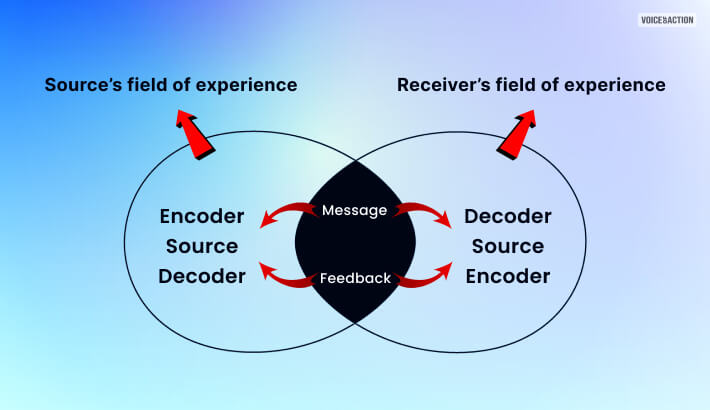Interactive Model Of Communication – What Does It Mean?

The interactive model of communication is one of the most famous models of communication. This model aims to explain the communication process involving the sender and receiver of the message. In addition, it considers the fact that communication can take place between a man and a machine as well.
To understand this model of communication in detail, read this article now and see its components and criticisms. A detailed example for better understanding will also be provided. It helps understand which of these is the easiest way of communication.
What Is The Interactive Model Of Communication?
In this model, the source acts at first. The message is encoded at its source. After that, the receiver collects the encoded message. Secondly, the receiver will decode the information in the message.
The first part of the message exchange is complete. Now, the recipient will reply. He will now encode his reply in a message. After that, he will send the message back to the initial source.
This message is called the feedback or criticism of the actual message.
The field of experience impacts both sources. The field of expertise amalgamates elements like culture, circumstance, etc. These factors come into play at the same time, impacting the message exchange.
Other variables impact the development and understanding of the message.
Concepts Of Interactive Model
The sender will encode the message at first. Then, he will send it across to the receiver. Now, the receiver will decode it. And find out the actual message.
This is the interactive model, in short. However, the rose will change after that.
The receiver will form a reply message (feedback or criticism) and send it to the original sender.
You cannot ignore the barrier and noise in this communication. It is the same as the network issues in a phone call. It impacts the whole communication.
Interactive Model Of Communication Components
According to the interactive model of communication, communication is a two-way process. Therefore, it has various components to explain the entire communication process. These components of the model are:
1. Encoder-Source-Decoder
Every form of communication has a source and a receiver. The source or speaker refers to the person who initiates the communication with the intent of delivering a message. On the other hand, the receiver or the listener is the other person the recipient of the message.
As per the interactive communication model, the source is considered the encoder of the message. He or she devices how the message is presented by encoding it in the form of an understandable language. On the other hand, the listener is the decoder of the message since he or she has to decode the language to understand the message.
In this state, the source is the person who sent the first message. But the message encoder and decoder are the same guy.
When he reacts to the message, he becomes the encoder of the reply message. But he also decodes the initial message. Hence, the second source is the encoder and the decoder simultaneously.
2. Message
Every communication starts with the intention of sending a message. This information is encoded in the form of a language that needs to be decoded by the listener to understand it. This information is referred to as the message according to the interactional model of communication.
3. Feedback
Feedback is the stage where the roles of the encoder and the decoder get reversed. Here, the listener decides to respond back to the message previously sent by the speaker. This message is referred to as feedback according to the interactive model of communication.
4. Field of Experience
The unique aspect of the interactive model that sets it apart from other communication models is the field of experience. This refers to the experience and knowledge both the encoder and the listener has. Therefore, this makes this model different from the transactional model of communication.
The interactive model places emphasis on this element of communication because it directly influences the encoding and decoding process. If either the encoder or the listener does not have enough experience, they will not be prosperity able to encode or decode the message.
5. Physical context
The environment is an essential context during communication. It can impact your interaction in many ways. That’s the main crux of the interaction model of communication.
Firstly, the location’s size and surrounding climate will affect your communication. The quality of lighting will also affect the process.
These factors matter more when you are dealing with someone in-person. Lastly, the configuration of software or any tool can also impact your digital communication.
In any communication, consider how these factors play out.
For example, you might have to attend multiple interviews at different locations for your job. Let’s say you interviewed in the first hour in an area. After that, you must attend another interview post-mid-hour at a different location.
Now you need a comfortable environment before your second interview during the afternoon. If you don’t get the same, it will impact the quality of your interview. Hence, we see how physical context impacts interview communication. The same also holds for corporate communication in any organisation.
6. Psychological context
It refers to all psychological and emotional factors impacting the communication process. Some of these factors are anxiety, stress level, and current emotional state.
When you are happy, you will reflect affection and excitement. For example, when you receive good news, it will affect your psychology. Hence you will communicate the same message in a particular way to others. Now, let’s assume a corporate example.
Imagine you received the LODs of a new project. You inherit an ambitious vibe with it. When you describe it to your juniors, you will speak in a motivating way.
In conclusion, you are a real-time emotion, and the psychological state decides how you convey the message.
Interactive Model Of Communication Examples
To fully understand the interactive model of communication, you must try to understand this example here:
Jack: Everyone is going to watch the movie today.
John: Are you inviting me or just informing me about this?
Jack: If you want, you can come, and if not, then it is ok not to come.
John: I would like to come!
Jack: Ok!
If you see, this is not a one-way communication example. According to the interactive model, Jack is the principal source sending the message, and John, as the listener, gets, deciphers, and offers his criticism on the message, which is then recognized by the principal source.
He currently turns into the shipper and communicates his message. As communication advances, it turns into a roundabout model as messages will be passed starting with one end and then onto the next.
Interactive Model Of Communication Criticisms
The primary criticisms of the interactive model of communication are:
1. Lack Of Simultaneous Feedback
While the interactive model acknowledges back-and-forth feedback as one of the primary essences of communication, it still misses something important. Most theorists have acknowledged the fact that it does not include simultaneous feedback as part of the communication model.
This trait makes this model great for explaining online communication but is not the best choice for direct face-to-face communication.
2. Same Pattern
Most theorists have claimed that the exclusion of simultaneous communication has made this model very static. The interactive model expects that all forms of communication follow the same process of exchange of messages.
FAQ (Frequently Asked Questions)
Some of the most commonly asked questions related to the Interactive model of communication are:
The main foci of a communication model are senders and receivers. Or the path of message exchange. However, this model is different. Here, the interaction process is more crucial. The actual message is not as important.
It is important for people to understand the model of communication. This is because understanding the model will lead to more clear-cut communication. It will improve your communication skills with others, along with understanding what is appropriate and what is not.
The interactive model validates the sender and receiver only. After some time, the position of both changes. However, the transaction model considers that both people are the sender and receiver simultaneously.
Unlike the interactive model, which suggests that participants alternate positions as sender and receiver, the transaction model suggests that we are simultaneously senders and receivers.
Conclusion
The interactive communication model has two primary agents – the encoder and the decoder. The encoder sends a message to the other person in communication. The receiver has to understand the message first. However, his knowledge and field of experience impact the process. After that, the listener will create a reply and send it across.
This model is effective for online communication. Here, two people are communicating through a virtual medium. Moreover, communication is slow and rigid. Meanwhile, there are continuous back-and-forth message exchanges. Therefore, a common criticism of this model is its static nature and lack of dynamics, constituting everyday communication.
More Resources:


























